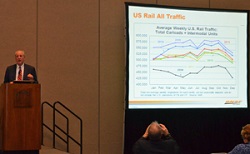 The American Soybean Association (ASA) is disputing the U.S. Environmental Protection Agency’s (EPA) findings critical on the efficacy of neonicotinoid seed treatments in soybean operations. ASA President and Brownfield, Texas, farmer Wade Cowan said “…soybean producers use neonicotinoid seed treatments where they are needed and effective, and don’t use them where not.” Cowan pointed to recent research from Mississippi showing approximately 90 percent adoption of neonicotinoid seed treatments signals that the technology does work for farmers in certain areas.
The American Soybean Association (ASA) is disputing the U.S. Environmental Protection Agency’s (EPA) findings critical on the efficacy of neonicotinoid seed treatments in soybean operations. ASA President and Brownfield, Texas, farmer Wade Cowan said “…soybean producers use neonicotinoid seed treatments where they are needed and effective, and don’t use them where not.” Cowan pointed to recent research from Mississippi showing approximately 90 percent adoption of neonicotinoid seed treatments signals that the technology does work for farmers in certain areas.
In the comments, Cowan noted that neonicotinoid seed treatment use is tailored to a very specific set of circumstances, and in those settings, that particular technology is critical, “Farmers balance the efficacy of different treatments based on their individual farms, and experience shows that farmers who purchase seed treatment for soybeans do so because it reduces or eliminates the need for application of additional inputs after the soybean seedling has emerged,” he said. “Seed treatments both protect the soybeans from insects in the soil after planting as well as protecting the seedlings as they emerge. A below-ground insect infestation has no rescue options except replanting, and in the northern growing regions, replanting is not often an option.”
“EPA must not allow political pressure to lead to restrictions on crop protection tools,” concluded Cowan. “We have appreciated EPA’s science-based decision-making in evaluating crop protection products, particularly as they are wrongly singled out as the cause of pollinator decline. We urge EPA to maintain its commitment to science in evaluating crop protection tools.”
You can read all of ASA’s comments here.









